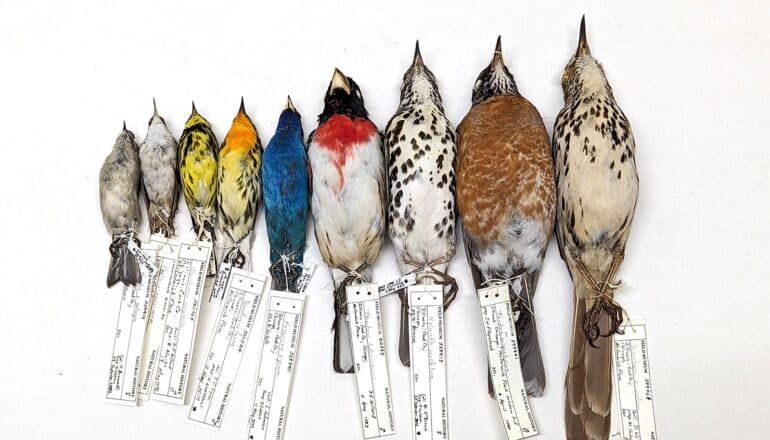
The bodies of birds across the Americas are getting smaller and longer-winged as the world warms, according to new resarch.
Smallest-bodied species are changing the fastest, the researchers report.
The new study combines data from two previously published papers that measured body-size and wing-length changes in a total of more than 86,000 bird specimens over four decades in North and South America. One study examined migrating birds killed after colliding with buildings in Chicago; the other looked at nonmigrating birds netted in the Amazon.
Though the two datasets are non-overlapping in both species composition and geography, and the data were collected independently using different methods, the birds in both studies displayed similarly widespread declines in body size with concurrent increases in wing length.
Now, the new analysis of the combined data has revealed an even more striking pattern: In both studies, smaller bird species declined proportionately faster in body size and increased proportionately faster in wing length.
“The relationships between body size and rates of change are remarkably consistent across both datasets. However, the biological mechanism underlying the observed link between body size and rates of morphological change requires further investigation,” says senior author Benjamin Winger, an assistant professor of ecology and evolutionary biology at the University of Michigan and an assistant curator at the Museum of Zoology.
Smaller bodies higher temps
Both the Chicago and Amazonian studies attributed the reductions in species body size to increasing temperatures over the past 40 years, suggesting that body size may be an important determinant of species responses to climate change.
Even so, exactly why smaller-bodied species are changing faster remains an open question, according to the researchers.
It could be that smaller-bodied birds are adapting more quickly to evolutionary pressures. But the available data did not allow the researchers to test whether the observed size shifts represent rapid evolutionary changes in response to natural selection.
“If natural selection plays a role in the patterns we observed, our results suggest that smaller bird species might be evolving faster because they experience stronger selection, are more responsive to selection, or both,” says co-senior author Brian Weeks, an evolutionary ecologist at the School for Environment and Sustainability. “Either way, body size appears to be a primary mediator of birds’ responses to contemporary climate change.”
Larger bodies, greater extinction risk?
So, if larger-bodied birds are responding more slowly to global change, what’s the prognosis for the coming decades, as temperatures continue to climb?
“Our results suggest that large body size could further exacerbate extinction risk by limiting the potential to adapt to rapid, ongoing anthropogenic change,” says lead author Marketa Zimova, formerly a postdoctoral researcher at the Institute for Global Change Biology and now at Appalachian State University.
“In contrast, the body-size effect on evolutionary rates might increase persistence of small taxa if their rapidly changing morphology reflects a faster adaptive response to changing conditions.”
The new study analyzed data from 129 bird species: 52 migratory species breeding in North America and 77 South American resident species. The 86,131 specimens were collected over roughly the same period using different techniques.
The smallest bird among the Chicago species was the golden-crowned kinglet (Regulus satrapa) at an average size of 5.47 grams, and the largest was the common grackle (Quiscalus quiscula) at 107.90 grams. Among the Amazonian species, the fork-tailed woodnymph (Thalurania furcata) was the smallest at 4.08 grams, and the largest was the Amazonian motmot (Momotus momota) at 131.00 grams.
The North American dataset was derived from birds retrieved by staff and volunteers at Chicago’s Field Museum after collisions with city buildings. For each of the 70,716 individuals, Field Museum ornithologist David Willard measured bill length, wing length, body mass, and the length of a lower leg bone called the tarsus.
“The birds collected from window collisions in Chicago are providing insights into morphological changes related to the changing climate. It is extremely gratifying to see data from these birds analyzed for a better understanding of the factors driving these changes,” says Willard, collections manager emeritus and a coauthor of the PNAS study.
The Amazonian dataset contains measurements of 15,415 nonmigratory birds captured with mist nets in the rainforest, measured, then released. Two measurements were consistently recorded throughout the study period: mass and wing length.
The large and complementary datasets provided a unique opportunity to test whether two fundamental organismal traits—body size and generation length—shaped the birds’ responses to rapid environmental change.
Generation length
Among biologists, it is broadly assumed that a species’ generation length, defined as the average age of individuals producing offspring, is an important predictor of its ability to adapt to rapid environmental change.
Shorter-lived organisms that reproduce on relatively short time scales, such as mice, are predicted to evolve faster than creatures with longer generation lengths, such as elephants, because the mice have more frequent opportunities to make use of the random genetic mutations generated during reproduction.
The authors of the new study used statistical models to test the importance of both generation length and species body size in mediating rates of morphological change in birds.
After controlling for body size, they found no relationship between generation length and rates of change in the North American bird species. Generation-length data were not available for the South American birds, so they were not included in that part of the analysis.
At the same time, the analysis showed that a species’ mean body size was significantly associated with the rates of change measured in both the Chicago and Amazonian birds.
“Body size may be a valuable predictor of adaptive capacity and the extent to which contemporary evolution may reduce risk of extinction among species,” the authors write.
Additional coauthors are from Penn State, the Integral Ecology Research Center, and the US Geological Survey. The Institute for Global Change Biology funded the work.
Source: University of Michigan
The post Bird bodies are shrinking as the world warms appeared first on Futurity.
from Futurity https://ift.tt/Pn8AW7h
No comments:
Post a Comment